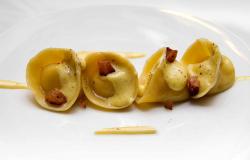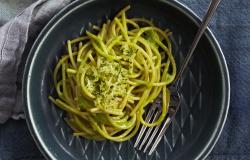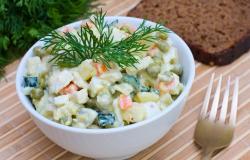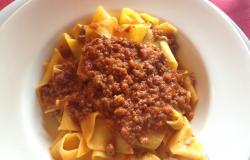Sicilian Eggplant Caponata
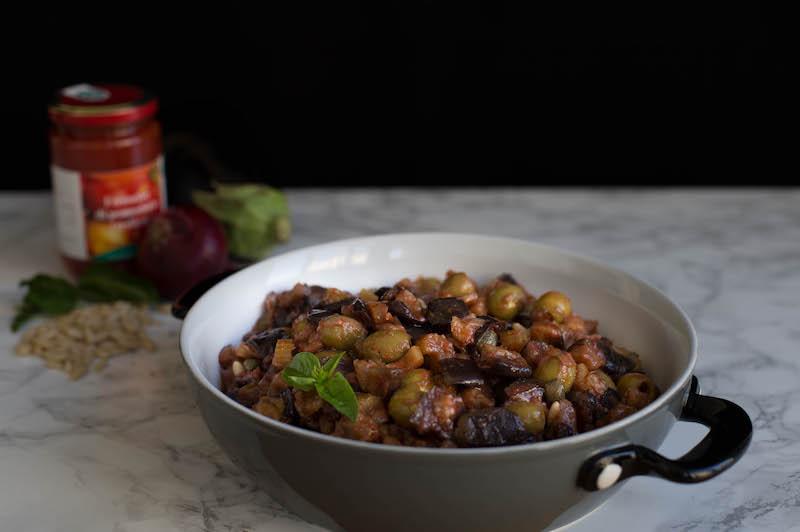
Eggplants — melanzane in Italian — were introduced to Sicily by the Arabs in the Middle Ages. Since then, this bulbous fruit has become a fixture in the island’s cookery. Acoording to Mary Taylor Simeti, author of Sicilian Food, any discussion of the myriad Sicilian recipes that use melanzane should begin with the sublime appetizer caponata. This dish, essentially a relish with an agrodolce (‘sweet-sour’) twist, consists of the following base ingredients: eggplant, onion, tomato sauce, celery, vinegar, capers, olives, basil, sugar and salt. There are, however, many variations all over the Sicilian isle which include the addition of capsicums, pine nuts, raisins, potatoes, zucchinis, carrots, cinnamon, tuna roe, swordfish and even lobster.
The origins of this caponata are shrouded in mystery. Some people contend that the dish’s name derives from the word capone, a Sicilian word meaning dolphinfish, and that it was originally an aristocratic fish-based preparation. Those who couldn’t afford fish bulked up their version with chunks of the humbler and readily available eggplant instead. Others argue that caponata derives from caupone, the name for sailors’ taverns, and that it was originally seagoing fare. There may be some basis, in fact, to the latter theory, since the presence of salt and vinegar stretches out caponata's shelf life. In fact, to this day, it is common in many Sicilian households to prepare large amounts of caponata in summer and preserve it in jars to enjoy year-round.
The recipe below is based on the city of Palermo’s interpretation of this dish, which also includes pine nuts and sultanas. For best results, plan ahead. You’ll need to set aside an hour to purge the eggplants and about 40-50 minutes for frying the eggplants and simmering these with the rest of the ingredients. After that, leave your caponata to rest for several hours (or better yet, overnight) to best appreciate that meltingly sweet yet tangy combination.
In a colander, place eggplant chunks and sprinkle generously with salt. Place a plate and another heavy object on top so as much bitter juice is extracted from eggplant chunks as possible. Leave to sit for an hour. Rinse eggplant chunks with water to remove excess salt. Squeeze eggplant chunks to draw out all the moisture and pat dry thoroughly with a paper towel or cloth.
Heat olive oil in a large frying pan. Fry the eggplant chunks. Take care not to overcrowd the pan. With the amount indicated in this recipe, fry a third of the chunks at a time. When the chunks are crisp and golden brown, remove from the pan with a slotted spoon and transfer to a plate lined with absorbent paper towels.
Fry the onion slices until translucent. Add the celery chunks, the green olives and the tomato passata and simmer covered on low to medium heat for 10 minutes.
At this point, add the capers, the fried eggplant, the pine nuts, the sultanas, the vinegar and the sugar. Stir ingredients so they are well-combined, taste and add salt as needed. If using salt-packed capers, you probably will not need much. Leave to simmer uncovered on low-medium heat for 20 minutes or until excess liquid has reduced.
Transfer to serving bowl, cover with aluminium foil and leave to rest for 2 hours at room temperature. If leaving your caponata for the following day, place in the refrigerator. Remove from the fridge one hour before serving to best enjoy the dish’s flavors. Garnish with a couple of basil leaves. Serve as an appetizer (ensure there is plenty of bread on hand!) or as an accompaniment to a fish-based main course.


